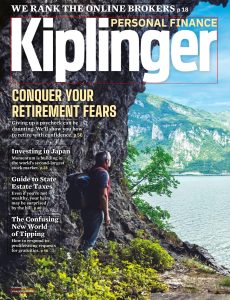
Kiplinger’s Personal Finance – October 2023
English | 76 pages | pdf | 20.84 MB
ALLOWEEN is just around the corner, and despite its spooky theme, the festivities that come along with it—carving jack-o’-lanterns, donning costumes, handing out candy (or, in my case, eating a cut of the treats that my kids collect)—are usually more fun than scary. What’s far more frightening for many Americans is the prospect of not having enough money for the future. In the most recent Chapman University Survey of American Fears, 54% of respondents shared that fear, and the same percentage were afraid of economic or financial collapse.
Those two fears tied as the seventh most common. (Number one? Corrupt government officials.) Such worries often translate into stress. A spring survey from CNBC found that 70% of Americans felt stressed about their personal finances.
And having a decent income doesn’t provide immunity—57% of those earning $100,000 or more felt stressed. Inflation was the top contributor to financial stress.
Although inflation is slowing down, consumers are still feeling the effects of the substantial price increases that started a couple of years ago. (And while lower inflation is desirable in many ways, it means that retirees can expect a smaller cost-of-living increase in their Social Security benefits next year—for more, see page 9.) Higher living expenses can make it harder to stash away money for the future, and 62% of respondents to a recent Schwab survey of 401(k) participants said that inflation is presenting obstacles to saving for a comfortable retirement. Inflation concerns hit those who are already retired, too.
As editor at large Janet Bodnar points out in her column on page 59, retiree confidence in having enough money to live comfortably through retirement is down significantly. Similar worries are common even among those who are reasonably well prepared for retirement. To go from collecting a paycheck to relying on investments and other sources of income is a significant leap mentally, and concerns about running out of money can cause workers to miss out on what could be some of their most enjoyable retirement years by unnecessarily delaying the transition. In our cover story this month, which starts on page 50, senior editor Sandra Block walks readers through the steps to retiring without fear. As with just about any other aspect of managing your personal finances, preparation is key to keeping financial worries at bay. If you feel that your savings are falling short—or you want assurance that your retirement stash will stack up—monitoring your cash flow can give you a better sense of control. Enlisting a financial planner who can take a holistic look at your spending and saving patterns can be a helpful exercise, too. You can search for a fee-only, fiduciary planner at napfa.org.
A different kind of financial anxiety. In the early days of the COVID- 19 pandemic, many customers were extra generous to service workers by leaving tips in instances where they normally weren’t expected—when picking up restaurant takeout orders, for example. In the years since, tip jars and digital prompts for tips on checkout screens have popped up at a range of businesses—and that has left many customers scratching their heads as to whether they are expected to tip, and if so, what the appropriate amount is. If you find yourself in that boat, read “To Tip or Not to Tip?” on page 46, which provides guidelines on setting a tipping strategy.
LISA GERSTNER, EDITOR
[email protected]
planner at www.napfa.org.
Download from: